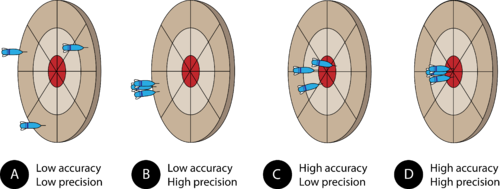Accuracy and Precision
Key points
- Accurate measurements are close to an accepted value, and are “near the bullseye”.
- Precise measurements are close to each other.
Measurement accuracy refers to how close the data collected is to an accepted value. The accuracy of measurement is dependent on the presence of systematic error.
Measurement precision refers to how close the data points collected are to each other. This is dependent on random error between trials.
Bullseye example:
- In example A, the data points are far from the bullseye and are far apart.
- Low accuracy and low precision.
- In example D, the data points are all right on the bullseye.
- High accuracy and high precision.
Frequently Asked Questions
- How can precision and/or accuracy be increased in a scientific experiment?
- Since precision is dependent on random error, and accuracy on systematic error, they can be increased by improving the data collection process to reduce both types of error.
- Why are precision and accuracy important in a scientific experiment?
- They are directly indicative of the quality of the data collected, and by extension, all analysis and conclusions.
Subscribe to the Inertia Newsletter
IB News, Covid-19 Updates, Deadlines, Tips and Tricks, and Hundreds of Free Resources are Awaiting You!
Features
- Study Notes
- Thousands of IB Questions
- Detailed Answers
- Ask-A-Question System


